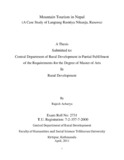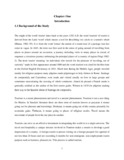Please use this identifier to cite or link to this item:
https://elibrary.tucl.edu.np/handle/123456789/3472Full metadata record
| DC Field | Value | Language |
|---|---|---|
| dc.contributor.author | Acharya, Rajesh | - |
| dc.date.accessioned | 2021-07-26T05:09:35Z | - |
| dc.date.available | 2021-07-26T05:09:35Z | - |
| dc.date.issued | 2011 | - |
| dc.identifier.uri | http://elibrary.tucl.edu.np/handle/123456789/3472 | - |
| dc.description.abstract | This thesis entitled “ Mountain Tourism in Nepal( a case study of Langtang Rastriya Nikunja ,Rasuwa “ is divided in six different chapters and concentrated on socio economic contribution of tourists in Langtang and identify the strengths and weakness of tourism industries in Langtang national park and its nearby area as well as socio-economic impact tourism in Langtang . This study showed that most tourists visiting (62%) Langtang are form Europe and mostly staying in the area for three four days period. Most of the tourists (80 percent) are found satisfied with the accommodation and service provided by the hotel and naturalists. Basically, they expressed their nation that they prefer to stay in new modern lodges instead of Tamang style lodges. Tourists entirely by air are 77.2 percent of the total arrivals where as those by land stand 22.8 percent in 2010. By age group the largest number goes to the group is 31-45 years 33.3 percent and 46-60 years 25.2 percent of the total tourist. The 80 percent tourists is agree in service satisfaction, 16 percent are disagree and 4% re indifference. The largest number of tourist representing 46 percent came from Western Europe, 44 percent, 8 parent and 2 percent from Asia, North America and Australia and 9 pacific respectively. In the present time there found certain change that host culture is replaced by the western culture and to an extent by hill magentas sculpture. Park people conflict can also be noticed in Langtang. This indicates that there is dire need of appropriate legal forma work addressing the compensation of the crops and livestock depredation to the natives. Kerosene and gas stoves are introduced in some houses instead of fire wood because the natives are not allowed to enter the part for the collection of resources. It is found that the natives have followed the modern system and techniques instead of rational are the modern system comprises of good irrigation system, improved seeds and chemical fertilizer and so on. Similarly, means of Agriculture such s tractor, sue of hand pump and others are introduced lately in this community. Mother group of Dhunchhe g in order to generate the income is very active to conduct adult class and training of knitting, sewing and weaving etc. Among the total shopkeeper 15 percent green vegetable supply to customer’s percent firewood 15 percent rice and wheat 0 percent fish and meat and 55 percent other (handicraft) | en_US |
| dc.language.iso | en_US | en_US |
| dc.publisher | Central Departmental of Rural Development | en_US |
| dc.subject | Mountain | en_US |
| dc.subject | Tourism | en_US |
| dc.title | Mountain Tourism in Nepal (A Case Study of Langtang Rastriya Nikunja, Rasuwa) | en_US |
| dc.type | Thesis | en_US |
| local.institute.title | Central Department of Rural Development | en_US |
| local.academic.level | Masters | en_US |
| Appears in Collections: | Rural Development | |
Files in This Item:
| File | Description | Size | Format | |
|---|---|---|---|---|
| Cover.pdf | 44.29 kB | Adobe PDF |  View/Open | |
| Chapter.pdf | 614.02 kB | Adobe PDF |  View/Open |
Items in DSpace are protected by copyright, with all rights reserved, unless otherwise indicated.
